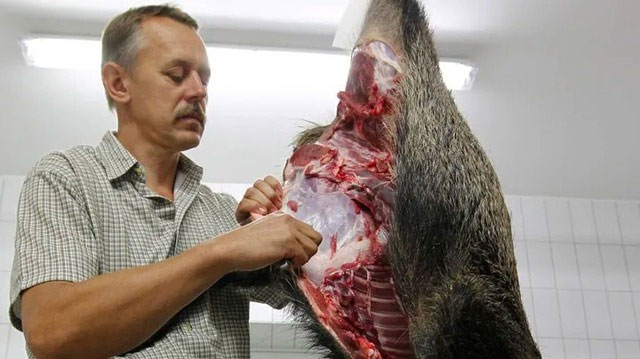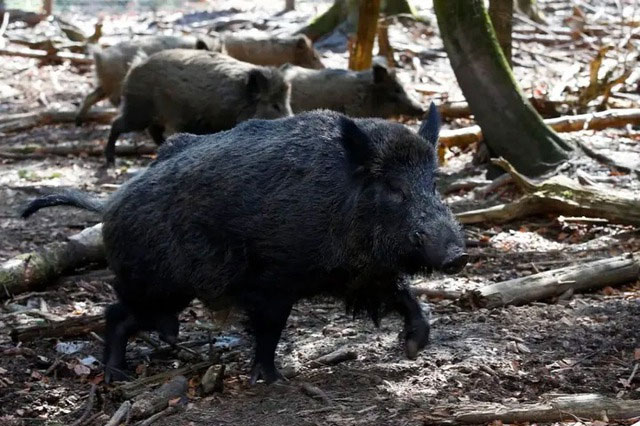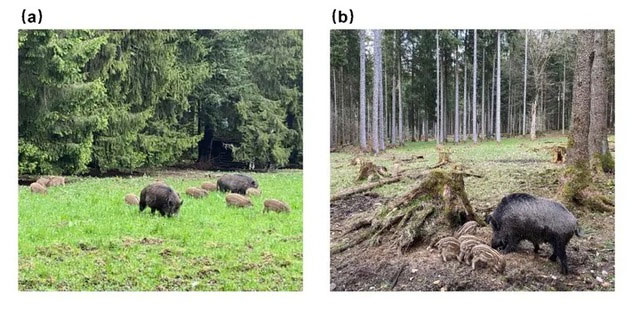Wild boars are rampant in Bavaria, Germany, but why doesn't anyone dare to eat them?
According to the Berlin Ministry of the Environment, in 2009, hunters in Bavaria were compensated nearly 425,000 euros for wild boar meat that could not be sold due to radioactive contamination.

A forest ranger holds a piece of wild boar meat near Munich, southern Germany on Wednesday, August 18, 2010. (Photo: AP Photo/Matthias Schrader)
Wild boar killed elsewhere in Germany can still be eaten because their meat does not contain high levels of radiation. According to local regulations, if the killed wild boar contains more than 600 becquerels of cesium per kilogram of meat, the meat can only be burned or buried.
In Bavaria, a forest bordering the Czech Republic, the concentration of cesium-137 in wild boar exceeded 7,000 becquerels/kg, about 11 times the minimum standard and completely inedible. According to research, the amount of radiation absorbed when eating 1 kg of wild boar meat is '10 times higher than the allowable limit' , equivalent to about 60% of the amount of radiation the human body absorbs each year under normal conditions.

To monitor local wild boar nuclear radiation levels, 70 monitoring stations have been set up in Bavaria and all hunted wild boar must undergo radiation testing.
Obviously, in Germany's history there has never been a nuclear leak or nuclear explosion, so why are wild boars there so severely radioactive? Starting in 2019, scientists began collecting 48 wild boar meat samples from hunters in Bavaria, and collection areas were distributed in various places. At each site, fresh muscle samples from killed wild boar were separated, frozen and shipped to Leibniz University in Hannover after the hunt.

In the laboratory, wild boar muscle samples were thawed at room temperature and then cut into smaller pieces (less than 2 cm in diameter) while ensuring complete removal of foreign matrix. The samples were then dried at 110°C for 24 h, then ashed by heating in an oven at 420°C for a total of 36 h and stored. The results showed that 88% of sampled wild boar meat had a cesium content higher than the limit prescribed by German law and 100% of the measured data exceeded the limit prescribed by Japan.

Ratio of Cesium-137 and Cesium-135 in wild boar from different regions of Bavaria.
Next, the researchers looked for isotopic signatures for identification. Scientists are particularly interested in two forms of cesium - cesium-137 and cesium-135 . Scientists can tell if they come from a reactor or a nuclear explosion based on the ratio of the two substances produced.
Scientists have discovered that all wild boar meat contains both cesium from the Chernobyl nuclear accident and radioactive cesium from nuclear fallout . It's just that the nuclear explosion contamination rate in different samples is different, ranging from 10% to 99%. In other words, in a quarter of the wild boar meat sampled, the amount of radiation alone from nuclear fallout was enough to make the meat dangerous and inedible.

The Chernobyl power plant is about 1,300km from Bavaria. After the nuclear reactor explosion in 1986, radioactive dust immediately spread into the environment, causing forest animals in Bavaria and other places to be contaminated with radioactive cesium.
During the Cold War, of the more than 2,000 nuclear bombs detonated around the world, 500 exploded in the atmosphere, releasing large amounts of radioactive material and creating large amounts of radioactive fallout. spread around the world according to wind direction, precipitation and subsidence. These particles are now almost everywhere in the soil, but they have generally decayed. Some radionuclides, such as Cesium-137 and Strontium-90, have long decay times and can persist in the environment for decades or even centuries, causing long-term pollution.
Due to rainfall, these radioactive substances are introduced into the soil. In the forest, some types of mushrooms (such as straw mushrooms, black truffles) absorb water and nutrients from the soil through fungal mycelium, and also absorb radionuclides in the soil such as Uranium, Plutonium, Cesium, Strontium, etc. These nuclei can persist in the soil longer in agricultural areas, especially in areas such as alpine grasslands, forests and plateaus.

Bavarian wild boar has few other food sources except mushrooms and black truffles.
Fungi have some special metabolic abilities that allow them to use radionuclides as an energy source. For example, some fungi can break down radioactive graphite from nuclear reactors or use melanin to absorb radiation and convert it into energy, just as plants use chlorophyll to convert light. Sunlight into energy through photosynthesis. These fungi grow faster under radiation and are more likely to accumulate radioactive material.
Therefore, organisms such as fungi have a high concentration factor (BCF). This refers to the ratio between the concentration of a certain substance in the body to the concentration of that substance in the environment. In general, the higher the BCF, the easier it is for the body to absorb and enrich substances from the environment. The BCF of mushrooms can reach hundreds, even thousands, much higher than that of other plants and animals. During the winter , Bavarian wild boars have few other food sources except mushrooms and black truffles , so they are especially vulnerable to the effects of nuclear radiation. This is why radiation levels in most animals decreased several years after the Chernobyl accident, but this did not happen with Bavarian wild boars.

Wild boar may have completed the reproductive process and died naturally before radiation-induced diseases appeared.
In addition, black truffles are difficult to find in the wild. But wild boars can smell black truffles through their sensitive noses. And when wild boars eat radioactive mushrooms, although they do not transform into monsters, they still have a certain impact on the environment and humans . Wild boars reproduce extremely quickly, and the population of these contaminated wild boars could get out of control because no one wants to eat them, hunters may not be willing to kill them, and government subsidies are limited. In this way, wild boars can cause a lot of damage to forest vegetation and nearby farms.
So the question is why do wild pigs still thrive despite being contaminated with nuclear radiation? Because the lifespan of wild boars is relatively short , usually only 4 to 5 years, and damage caused by nuclear radiation to the creature often takes years or decades to appear. Therefore, wild boars may have completed the reproductive process and died naturally before radiation-induced diseases appeared , so they could still maintain population stability.
In addition, wild boars also have certain resistance and resilience and can adapt to environments with high radiation. Several studies have found that wild boars exposed to low doses of radiation in Fukushima over a long period of time do not exhibit biological signs of stress and DNA damage such as shortened telomeres and elevated cortisol levels. , indicating that their overall health was not significantly affected.
- Surrounded by lions, wild pigs use 'excellent skills' to escape with unbelievable simplicity
- Fukushima is flooded with radioactive wild boar
- Dogs and wild boars died in a bloody fight in Indonesia
- Wild boars dig snow for food
- The unknown things about wild boar
- H5N1 recurred in Germany
- American wild boar 'invades' Mexico
- Raising wild boar
- Raising wild pigs
- The island was suddenly invaded by an army of wild boars
- Video: Mysterious circle on the field in Germany
- The jaguar is dreadful,
 'Fine laughs' - Scary and painful torture in ancient times
'Fine laughs' - Scary and painful torture in ancient times The sequence of numbers 142857 of the Egyptian pyramids is known as the strangest number in the world - Why?
The sequence of numbers 142857 of the Egyptian pyramids is known as the strangest number in the world - Why? History of the iron
History of the iron What is alum?
What is alum?